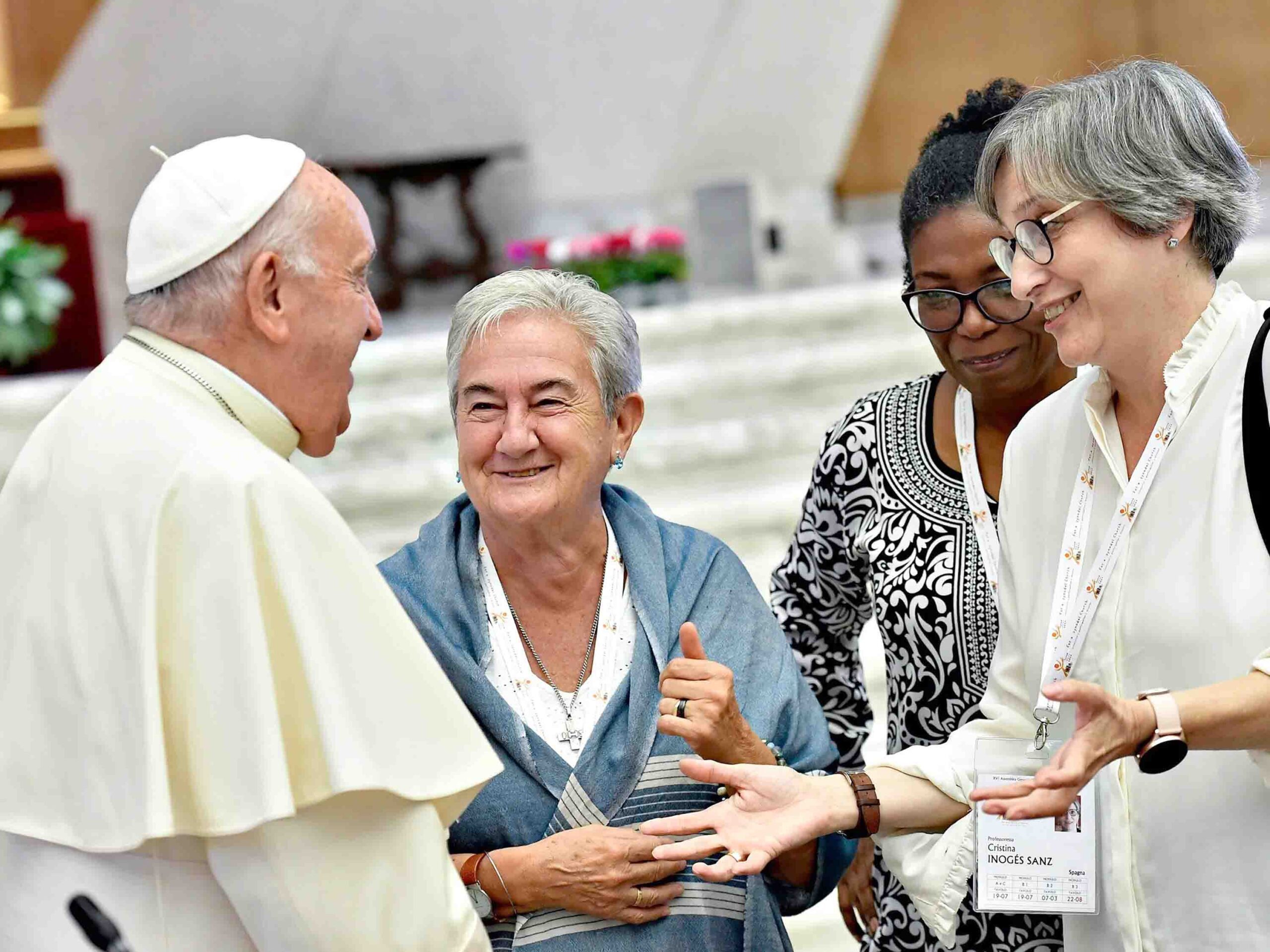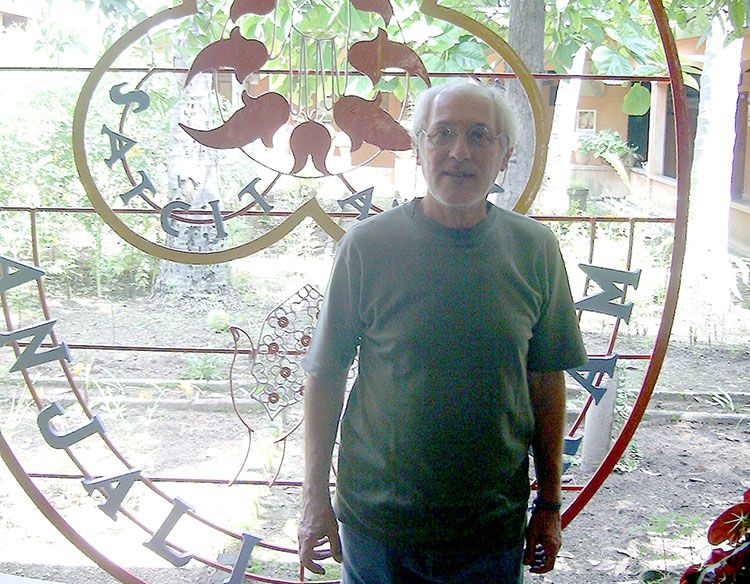Christmas, that singular feast of great joy, celebrates the revelation of God’s love. In Jesus, born of Mary, we recognize God’s tender compassion, not from a distance, but intimately united with all humanity. We are convinced, in the words of the Christmas liturgy, that because God has become one with humanity, we humans can once again become one with God. Indeed, no human eye could ever see the glory of God; yet, now He is seen as one like us, completely human, sharing our mortal nature. In Jesus, the invisible love of God is made visible – all done for us and for our salvation. What mystery! What beauty! What depths of love!
And yet, Christmas is not the beginning of God’s great “love story” with humanity. Christmas (December 25) looks to a pivotal event that happened nine months earlier: the Annunciation (March 25). Without the marvelous fiat or “yes” of Mary to the invitation of the Angel Gabriel, there would be no Christmas to celebrate. During the Annunciation, Mary expresses her amazement, her fears, and her questions. The angel assures her: “The Holy Spirit will come upon you … nothing is impossible to God.” Mary responds: “Here am I, the servant of the Lord; let it be with me according to your word” (Lk. 1:35-38).
The awareness of the centrality of the Annunciation in God’s plan of salvation struck this author most forcefully during a two-week pilgrimage to the Holy Land some years ago. Of all the many holy sites we visited during our prayer-filled journey, I had the most profound spiritual experience in Nazareth at the Basilica of the Annunciation. It was an experience of deep joy and gratitude. I praised God for Mary’s faith, her generosity, her fiat, and her openness to the Holy Spirit. A question kept returning, begging for an answer: What if Mary did not give her unconditional “yes” to God’s loving design of salvation? Oh, how radically different life would have been! Humanity would still be living in darkness and sin! What good would life have been without Mary’s self-gift to the Spirit and the consequent birth of Christ?
Scripture provides a wide variety of optics through which Christians can view the person of Mary. She may be validly understood as the Faithful Disciple of her Son Jesus, the Mother of the Redeemer, Virgin and Mother, Daughter of Zion, the New Eve, a Sign of Hope for God’s Pilgrim People. One could compose a lengthy reflection on each of these attributes of Mary. However, this particular presentation and meditation centers on viewing Mary as the docile instrument of the Holy Spirit. We will journey with Mary in the key events of her life where her active surrender to the Holy Spirit guides her faith and her actions.
Mary and the Spirit in God’s Design. Pope John Paul II (1920-2005), a deeply Marian pontiff, had profound insights into the person of Mary. He spoke often of her role in the life of the Church and of all Christians; he is well known for his encyclical Redemptoris Mater (Mother of the Redeemer) issued on the Feast of the Annunciation in 1987. Typically, the Pope exhorts Christians: “Let us turn our gaze to Mary, ‘the woman who was docile to the voice of the Spirit, a woman of silence and attentiveness, a woman of hope’” (November 30, 1997). In his first encyclical, Redemptor Hominis (1979), he had carefully noted how “the mystery of the Redemption took shape beneath the heart of the Virgin of Nazareth … under the special influence of the Holy Spirit” (22).
Reflection on the role of the Holy Spirit in the life of Mary is enriched if set within a comprehensive theological framework. Such an interpretive key is suggested by the full title that Vatican II gave to its eighth chapter of Lumen Gentium where one finds the Council’s discussion on Mary. The Latin original reads: “De Beata Maria Virgine Deipara in Mysterio Christi et Ecclesiae” (“The Role of the Blessed Virgin Mary, Mother of God, in the Mystery of Christ and the Church”).
Following the lead of the Council, this presentation adopts the framework that locates Mary within the divine mystery of salvation. At every turn, the isolated instances where Mary is presented in Scripture are integrated within a total history of salvation. Mary is thus portrayed as having a unique role in unfolding God’s salvific design through the power of the Holy Spirit.
While honoring Mary with many titles drawn from Scripture and tradition, the Second Vatican Council notes that “the maternal duty of Mary towards humanity in no way obscures or diminishes the unique mediation of Christ” (LG, 60). Mary’s role must always be seen as subordinate to and anchored within God’s mysterion, His comprehensive plan of salvation. Pope Paul VI succinctly noted this basic principle: “The Holy Spirit first, Mary second.” Mary is always an active recipient of God’s action, yet, a true collaborator. Her entire life – from beginning to glorification – is a constant faith response to the action of the Spirit; her life becomes a series of fiats.
It would be inaccurate to somehow “semi-deify” Mary because she gave such a perfect faith-response to God’s action in her life. Likewise, it would minimize her true “pilgrimage of faith” if, because she was perceived as “super-human,” Mary’s faith-struggles (Nazareth, Bethlehem, Egypt, Calvary, etc.) were then not those of a fully human person. Pope John Paul II speaks eloquently of “her personal journey of faith … [within] the mystery of salvation” (RMa, 5). Mary is a genuine, faith-full disciple. Through faith she enabled the Holy Spirit to abide in her as in a holy temple; her human personality became so transparent to the Spirit that she can properly be called “Sanctuary of the Holy Spirit.”
This presentation now shifts to an examination of those key moments drawn from Scripture and Church reflection wherein the Spirit-Mary relationship is expressed. Each “event” is presented, its source in Scripture and Church teaching is indicated; insights from popes, saints, and theologians will elucidate the Spirit-Mary Dynamic of the event. This approach intends to enhance the reader’s reflective understanding and appreciation of Mary and the Spirit.
Mary’s Immaculate Conception
Pope Pius IX in Ineffabilis Deus on December 8, 1854 wrote: “We declare, pronounce and define: the doctrine which holds that the Most Blessed Virgin Mary was, from the first moment of her conception, by a singular grace and privilege of Almighty God and in view of the merits of Christ Jesus the Savior of the human race, preserved immune from all stain of original sin, is revealed by God and, therefore, firmly and constantly to be believed by all the faithful.”
Pope Paul VI described Mary’s Immaculate Conception by noting: “It was the Holy Spirit who filled Mary with grace in the very first moment of her conception, thus redeeming her in a more sublime way in view of the merits of Christ, the Savior of humankind, and making her the Immaculate One.” From the very first moment of her existence, Mary was being prepared by the Spirit for the sublime task that awaited her.
The Immaculate Conception does not signify a special grace that was given to Mary at some later point of her life; it describes her person, her nature – from the beginning of her existence. She can truly say (as she did to Bernadette): I am the Immaculate Conception. Mary’s whole being becomes a temple of God; the Holy Spirit dwells in her in a very special way. Mary has been “fashioned by the Holy Spirit into a new substance and new creature” (LG, 56).
The Annunciation to Mary
Saint Luke’s beautiful story of the Annunciation (1:26-38) is a very clear statement on the role of the Holy Spirit: “The Holy Spirit will come upon you, and the power of the Most High will cover you with its shadow” (1:35). “For nothing is impossible to God” (1:36). “I am the handmaid of the Lord … fiat mihi secundum verbum tuum” (1:37-38).
All is grace: the angel Gabriel announces the unfolding of the mystery through the power of the Spirit. Mary’s response – free, prayerful, generous – is that she be worthy of the divine plan. Mary’s “yes” to God was flaming with faith; it was an unqualified assent. It was given in holy silence. Mary becomes the perfect type of the servant and agent of the Holy Spirit. She now has a personal relationship with the Holy Spirit, whom John Paul II calls “Person-love” and “Person-gift” (DV, 10, 22, 50). This relationship will grow, blossom, and bear fruit in her very being, her person.
What richness is included in that simple word: fiat! It is the only authentic response possible to God’s marvelous design. John Paul II’s encyclical Redemptoris Mater is fashioned around Mary’s fiat. The pope writes: “In these reflections … I wish to consider primarily that ‘pilgrimage of faith’ in which ‘the Blessed Virgin advanced’” (5). Saint Augustine poetically captures Mary’s profound faith when he writes: “Maria concepit Christum in corde [mente] priusquam in carne [ventre].” Yes, Mary’s conception in her faith precedes the conception in her flesh. Faith is nothing less than living into God’s mystery.
The Virginal Conception
Flowing from Mary’s fiat is her virginal conception of the Word-made-flesh. Matthew states that Mary the Virgin is “with child through the Holy Spirit” (1:18). Joseph is advised that “what she has conceived is in her by the Holy Spirit” (1:20). John Paul II declared that the “union of divinity and humanity in the one Person of the Word-Son, that is the ‘hypostatic union,’ … is the Holy Spirit’s greatest accomplishment in the history of creation and in salvation history” (June 6, 1990).
Matthew notes that the fruit of this virginal conception will be a Son to be called Emmanuel, a name which means “God-is-with-us” (1:23) – equivalently “Word-made-flesh” (Jn. 1:14). All this is made possible because Mary gave the Spirit total freedom in her life. It is accurate to hold that Mary’s fundamental charism was that of receiving the gift of the Spirit; she allowed the Christ-seed to be sown in her; she allowed the Body of the Son of God, the Incarnate Word, to be formed in her. Indeed, the mystery of the Redemption took shape beneath the heart of Mary. Enduring intimacy is a defining characteristic of the relationship between the Holy Spirit and the Virgin Mary.
The Incarnation is truly a profound mystery. By her consent to be the Mother of Jesus Christ, Mary gave an extraordinary demonstration of faith. She expressed her acceptance of the divine gift of salvation, not only for herself but for all humankind. In God’s design she was to continue to be intimately involved in the great saving mission of her Son. She was to be His Mother – even in his role as Redeemer of humanity. Mary’s faith bears marvelous fruit: the Word is made flesh!
The Visitation to Elizabeth
The Visitation story is chronicled in Luke 1:39-45. The scene sees Mary, filled with the Holy Spirit and impelled by love, rushing to the aid of her cousin Elizabeth who also is pregnant – even in her old age. In God’s loving plan, nothing is impossible. What a scene of great joy! Mary and Elizabeth, both faithful women of Israel, have been blessed by God.
When Mary enters Zechariah’s house, Elizabeth replies to Mary’s greeting and feels the child leap in her womb; being filled with the Holy Spirit, she greets Mary enthusiastically: “Of all women, you are the most blessed, and blessed is the fruit of your womb” (Lk. 1:42).
Note the active presence of the Holy Spirit in this scene. Mary, prompted by the Spirit, undertakes a difficult journey into the hill country; she went in haste; she was on a mission of service. She could have rationalized staying at home. When she arrives at Zechariah’s house, her presence brings the Holy Spirit to both Elizabeth and the child in her womb. Prompted by the Spirit, Elizabeth responds with a blessing; the unborn baby leaps in her womb.
Recall that Luke says that Elizabeth was “filled with the Holy Spirit” (1:41) when she uttered her words. Those filled with the Spirit can recognize God’s design, praise and thank God for it, and joyfully accept their role in the unfolding of this loving plan. Two generous, holy women share their faith. Both would be mothers of important and significant figures in God’s salvific design; faith-filled, Spirit-inspired women are central to the workings of God.
Mary’s Spirit-Inspired Magnificat
The prayerful, poetic genius of Saint Luke is manifested in Mary’s hymn of praise known as the Magnificat (Luke 1:46-55); it is sung daily in the heart of the Church during Vesper prayer. When the Church celebrates Marian feasts, her liturgy notes that “it is our special joy to echo her song of thanksgiving [Magnificat]. What wonders you have worked throughout the world! All generations have shared the greatness of your love” (Preface II of the Blessed Virgin Mary).
This beautiful song of gratitude, sung under the Spirit’s inspiration, is a brief, yet profound, synopsis of how God intends to unfold His design, what His plan of salvation entails, and what role Mary will play. The Magnificat asserts many profound truths: salvation comes from a loving God and is a cause for rejoicing; lowly servants like Mary play important roles in God’s design; God does great deeds for His faithful people; mercy, shown to Israel’s ancestors, will extend from age to age and the promises to Israel will be fulfilled; the world’s secular values will be subverted and inverted; God’s plan will be for all peoples and for all generations. The Magnificat is a sublime example of authentic prayer inspired by the Holy Spirit.
John Paul II wrote in Redemptoris Mater: “The Church’s love of preference for the poor is wonderfully inscribed in Mary’s Magnificat…. Mary is deeply imbued with the spirit of the ‘poor of Yahweh’.” Thus, “drawing from Mary’s heart, from the depth of her faith expressed in the words of the Magnificat, the Church renews ever more effectively in herself the awareness that the truth about God who saves, the truth about God who is the source of every gift, cannot be separated from the manifestation of His love of preference for the poor and humble.” The entire Church looks to Mary “as Mother and Model … in order to understand in its completeness the meaning of her own mission” (RMa, 37).
Mary Reflects on the Events of Jesus’ Birth-Childhood
This section presents a composite picture of the role of Mary and the Holy Spirit in the events of the birth and childhood of Jesus. It incorporates several passages from the infancy narratives of Luke and Matthew: birth (Lk. 2:1-7); visit of shepherds (Lk. 2:8-20); visit of magi (Mt. 2:1-12); sojourn in Egypt (Mt. 2:13-15); life at Nazareth (Lk. 2:39-52; Mt. 2:19-23); presentation in the temple (Lk. 2:22-38). How did Mary follow the promptings of the Holy Spirit during those many years of her “hidden life” with Jesus and Joseph?
Luke portrays Mary as a woman of constant reflection. In three instances, he focuses on Mary’s “response of the heart.” As the shepherds depart, Luke writes: “As for Mary, she treasured all these things and pondered them in her heart” (2:19). Simeon in the temple predicts that “the secret thoughts of many hearts [including Mary’s] will be laid bare” (2:34-35). When the Holy Family returned to Nazareth after Jesus was found in the temple, “His mother stored up all these things in her heart” (2:51). She lived the injunction of the Hebrew Scriptures: “Be still and know that I am God” (Ps. 46:10).
This experience in the temple – and Mary’s overall faith response – is well captured by John Paul II. “Simeon’s words seem like a second Annunciation to Mary, for they tell her of the actual historical situation in which the Son is to accomplish His mission, namely in misunderstanding and sorrow…. [They reveal that] she will have to live her obedience of faith in suffering, at the side of the suffering Savior, and that her motherhood will be mysterious and sorrowful” (RMa, 16). Christians can learn from Mary’s experience that meditation (prayer of the heart) is essential for integrating faith with the concrete events of life.
The Mother of Jesus at Cana
Examination of the text of John 2:1-11 that records the wedding at Cana reveals no explicit mention of the Holy Spirit. Yet, Paul VI (May 13, 1975) identifies this as an important event that manifests Mary’s responsive openness to the Spirit. He writes: “It was the Holy Spirit who urged the compassionate Mary to ask her Son for that miraculous change of water into wine at the wedding feast of Cana, which marked the beginning of Jesus’ activity as a wonder-worker and led His disciples to believe in Him.”
The encyclical Redemptoris Mater devotes a lengthy section to the Cana scene and Mary’s Spirit-inspired actions. “Mary is present at Cana in Galilee as the Mother of Jesus, and in a significant way she contributes to that ‘beginning of the signs’ which reveal the messianic power of her Son” (RMa, 21). The Cana event “offers us a sort of first announcement of Mary’s mediation, wholly oriented toward Christ and tending to the revelation of His salvific power” (RMa, 22).
The liturgical preface for Our Lady of Cana builds on this theme: “With loving care for the bridegroom and his bride, she turns to her Son for help and tells the servants to do what He commands. Water is changed into wine [and] the wedding guests rejoice…. In this great sign, the presence of the Messiah is proclaimed, the outpouring of the Holy Spirit is foretold, and the hour of salvation is foreshadowed.” Truly, sensitivity and compassion for human need result in outpourings of the Holy Spirit.
Mary at the Foot of the Cross
Christians feel particularly close to Mary in the stabat mater scene as she stands at the foot of the cross. Vatican II gave prominence to this scene: “the Blessed Virgin advanced in her pilgrimage of faith, and loyally persevered in her union with her Son unto the cross. There she stood, in keeping with the divine plan (cf. Jn. 19:25). There she united herself with a maternal heart to His sacrifice, and lovingly consented to the immolation of this Victim which she herself had brought forth” (LG, 58).
Numerous writers carefully note that Calvary was a significant moment in Mary’s fiat. Cardinal Suenens observed that Mary’s surrender and consent “did not remain on the level of her initial response. It grew through the darkness of the Cross … [as] an actual and personal reality.” R. Laurentin notes: “Mary will live this consent [fiat] to communion with Jesus without restriction until Calvary.” G. Maloney writes: “At the foot of the Cross especially did Mary experience the final purification of the Holy Spirit…. She wrung from the depths of her being, through the power of the Holy Spirit’s faith, hope, and love within her, her renewed ‘fiat.’ … The unifying, transforming power of the Holy Spirit brought Mary into a new level of oneness with the Father, Son, and Holy Spirit that was in proportion to her sorrows.”
In the same vein, John Paul II writes in his encyclical on Divine Mercy: “No one has experienced, to the same degree as the Mother of the Crucified One, the mystery of the Cross…. No one has received into his heart, as much as Mary did, that mystery, that truly divine dimension of the Redemption effected on Calvary by means of the death of the Son, together with the sacrifice of her maternal heart, together with her definitive ‘fiat’” (Dives in Misericordia, 9). Christians are to stand in solidarity with Mary on all the Calvaries of the world.
Mary and her Maternal Mission
With great tenderness, John the Evangelist (Jn. 19: 26-27) records the words of Jesus on Calvary to “His mother and the disciple He loved standing near her.” The Spirit’s presence and action in the episode is noted by Pope Paul VI (May 13, 1975): “It was the Holy Spirit who filled the Sorrowful Mother with immense love, widening and deepening her heart, as it were, so that she might accept, as a last testament, from the lips of her Son her maternal mission with regard to John, the beloved disciple: a mission which, ‘as the Church has always understood it,’ prefigured her spiritual motherhood toward humankind as a whole.”
Mary on Calvary is manifested to the world as the Mother of the Redeemed. We, like John the disciple, can go to her. This marvelous fact does not make Mary “co-redeemer” (a term avoided by Vatican II). Under the Spirit’s influence, Mary humanly cooperated in the acceptance of God’s salvation. The words of Vatican II are clear: “The maternal duty of Mary toward men, in no way, obscures or diminishes [the] unique mediation of Christ, but rather shows its power” (LG, 60). The Council does speak of Mary as “Mediatrix” in a carefully nuanced presentation; Vatican II notes that the use of such a term must “neither take away from nor add anything to the dignity and efficacy of Christ the one Mediator” (LG, 62). The entire third chapter of John Paul II’s Redemptoris Mater is devoted to a reflection on the “maternal mediation of Mary” (RMa, 38-50).
This Calvary scene is understood as one of the three key moments in Mary’s motherhood. First, in Nazareth, Mary becomes the mother of Jesus spiritually [mente] and physically [ventre] by welcoming Him into her heart in faith. Secondly, at the foot of the Cross she becomes the Spiritual Mother of all (represented by Saint John). Finally, at Pentecost, she becomes specifically “Mother of the Church” – a Marian title given by Paul VI on November 21, 1964.
Mary with the Church at Prayer and Pentecost
Building upon the Lukan narration of the Church at prayer (ecclesia orans) and the Pentecost event (Acts 1:14-2:13), Paul VI (May 13, 1975) writes in his characteristically poetic manner: “It was the Holy Spirit who raised Mary on the burning wings of love so that she might be a model intercessor during those hours in the Upper Room when the disciples of Jesus ‘together … devoted themselves to constant prayer’ along with ‘some women … and Mary the Mother of Jesus’ and waited for the promised Paraclete.”
Several eminent theologians have written on the role of the Spirit and on the presence of Mary at Pentecost, when the Church is fully born and sent into the world in the power of the Spirit. H. von Balthasar holds that at Pentecost the Church, as a subject, begins to be present in Mary and is perfected through the mystery of the Holy Spirit; “Mary’s living faith is the perfect prototype of what is expected in the life of the Church.” For A. Schmemann, “Mary is truly the icon and the epiphany of the Church – of the Church as life in Christ and of the Church as Christ’s life in us.” Y. Congar writes: “Mary has a pre-eminent place in the Christian mystery as the model of the Church and of universal intercession. This is the work of the Spirit in her.”
Other writers highlight the clear parallelism between the Incarnation and Pentecost. Bishop Kevin McNamara notes: “At the Annunciation, Mary cooperated with the Spirit in the Incarnation of the Messiah, destined to be the Savior and ruler of His people; at Pentecost she cooperates with the Spirit in the emergence of that people on to the stage of human history. She, who had first become the Mother of Christ, is now revealed as Mother of the Church, and central to her motherhood on each occasion are the humility, obedience and loving trust in God which unite her profoundly to the Holy Spirit.”
The Assumption of Mary into Heaven
On November 1, 1950 in the apostolic constitution Munificentissimus Deus, Pius XII defined, as an article of faith, the Assumption of Mary into the glory of heaven. Twenty-five years later, Pope Paul VI wrote: “It was the Holy Spirit who brought love to its supreme pitch in the soul of Mary while she was still a pilgrim on earth and made her yearn for reunion with her glorified Son. The Holy Spirit thereby disposed her for her crowning privilege: her Assumption, body and soul into heaven.”
The Assumption, as understood by Byzantine Christians, is Mary’s demise, koimisis, a dormition, a restful sleep, a repose rather than a death. When Pius XII defined the dogma, he carefully noted: “Mary ever Virgin, when the course of her earthly life was ended, was taken up body and soul into the glory of heaven.” Saint John Damascene asserted that Mary’s earthly departure should not be called death. In addition, Vatican II asserts Mary’s Assumption “upon the completion of her earthly sojourn” (LG, 59). These few quotes enable believers to understand the Assumption as the Spirit’s unique gift to Mary.
Belief in the Assumption affirms Mary’s link to Jesus. Through her Assumption, she becomes more thoroughly conformed to her Risen Son. Christ’s Resurrection and, subsequently, Mary’s Assumption stand as two pillars of Christian faith in full resurrection. Through the power of the Spirit, Mary remains uniquely linked to Christ – whether in the Incarnation, the life at Nazareth, Calvary, or in her glorious Assumption.
Mary as our Heavenly Intercessor
Although enjoying the full glory of heaven, Mary does not abandon her sons and daughters in the Church. Vatican II expresses Mary’s continual maternal presence in this way: “For, taken up to heaven, she did not lay aside this saving role, but by her manifold acts of intercession continues to win for us gifts of eternal salvation” (LG, 62). Or again, “In the bodily and spiritual glory which she possesses in heaven, the Mother of Jesus continues in this present world as the image and first flowering of the Church” (LG, 68). “Mary’s maternity will last without interruption until the eternal fulfillment of all the elect” (LG, 62). Indeed, “Mary [is] a sign of sure hope and of solace for God’s people in pilgrimage” (LG, 68-69).
Pope Paul VI speaks eloquently on this special gift of the Spirit enabling Mary to be our intercessor (May 13, 1975). He notes that her place in heaven does not “put an end to Mary’s mission as associate of the Spirit of Christ in the mystery of salvation…. She continues to be spiritually present to all her redeemed children…. Mary’s motherhood in the economy of grace goes on unceasingly.”
Mary’s role as spiritual mother and intercessor is not something vague, remote or abstract. It is an intimate, consoling, fruitful relationship. The Spirit is always at work here; every spiritual experience, including our relationship with Mary as mother and intercessor, is accomplished only through the mediation of the Spirit of Christ. This means, therefore, that as we seek to draw closer to Mary in the Church, we will concomitantly become more aware of the action of the Holy Spirit in our lives.
Totus Tuus (Totally Yours) was on the apostolic coat-of-arms of John Paul II; it proclaimed his total dedication to Mary. He committed every aspect of his life and the life of the Church to her. Even in times of great difficulty and suffering (e.g. the assassination attempt), John Paul II, quoting Saint Louis-Marie Grignion de Montfort, proclaims: Totus tuus sum, O Maria, et omnia mea tua sunt (I am totally yours, and all that I have belongs to you). All Christians also proclaim: Totus tuus sum.
Concluding Reflection. Mary’s faith-journey is a precious treasure for Christians who wish to understand the role of the Holy Spirit in one of God’s special, humble handmaids; Mary’s experience is a gift of the Spirit. Since as Cardinal Suenens notes, she is “a charism of the Spirit in person,” Christians can learn from Mary “to believe more purely, to discern the Spirit more clearly, to listen to the Word more intently, and to await more creatively the hour of the Lord’s coming.” Yes, through Mary and the Spirit, we can enter more fully into God’s plan of salvation – in all its profound beauty.
Mary’s relationship to the Spirit is at its foundation an awareness and surrender to God’s loving action in her person and her life. She allowed herself to be “a woodwind for the Lord,” to play God’s song with the Spirit’s pure and tranquil melody. She said fiat. In the famous words of C. Houselander, Mary sings: “I am your reed…. Now, if you will, breathe out your joy in me.”
The prayer of St. Ildefonsus of Toledo is a fitting way to conclude these reflections and humbly lay them at the feet of Mary:
I beg you, I beg you, O holy Virgin, that I may
have Jesus from the Spirit from whom you conceived
Jesus. May my soul receive Jesus through the
Spirit, through whom your flesh conceived the same
Jesus. Let it be granted to me to know Jesus from
the Spirit, from whom it was given to you to know,
to have and to bring forth Jesus. May I, in my lowliness,
speak exalted things of Jesus in that Spirit, in whom
you confess yourself to be the handmaid of the Lord,
choosing that it be done unto you according to the
angel’s word. May I love Jesus in that Spirit in which
you adore Him as Lord, contemplate Him as your Son.















